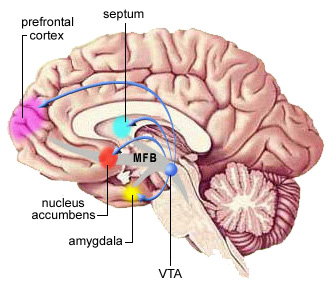


|

|
|
THE ISLAND
Part I:
Part II: |
YOUNG GIRLS AND PHONES (December 5, 2010)
How can we make sense out of all of this? Why should it be so hard to do something as simple as reducing or eliminating phone use? In order to explain why and how this happens, I'd like to introduce you to the concept of the "pleasure center", a system within your brain that, when stimulated, creates pleasurable feelings. The existence of a pleasure center was first hypothesized in the early 1950s by two Canadian researchers at McGill University, James Olds and Peter Milner. In December 1954, Olds and Milner published a classic paper describing an experiment in which they implanted thin needles with electrodes into various areas within the brains of rats, one needle per rat. Each rat was able to press a lever that would send a small electric current through the needle, thereby stimulating a specific part of its brain.[7] For the experiment, Olds and Milner used 15 male rats, all of whom were given 6-12 hours of time during which the electrode could be activated by pressing the lever. Of the 15 rats, 6 were fortunate enough to have their electrode inserted into an area that created a good feeling when turned on. On the average, these 6 rats ended up pressing the lever more than 81 percent of the time. One rat — history does not record his name — distinguished himself by pressing the lever 92 percent of the time! Olds and Milner thus concluded: "There are numerous places in the lower centers of the brain where electrical stimulation is rewarding, in the sense that the experimental animal will stimulate itself in these places frequently and regularly for long periods of time if permitted to do so." These specific areas of the rats' brains came to be known as the PLEASURE CENTER, and subsequent research revealed that similar areas exist in the human brain.[8] Modern thinking now considers the human pleasure center to be a sophisticated system of connections within the brain culminating in a small collection of neurons called the NUCLEUS ACCUMBENS (see the figure below). The nucleus accumbens plays a crucial role with respect to pleasure, reward, laughter, addiction and, interestingly enough, the placebo effect.[9] The principal brain chemical that controls the operation of the nucleus accumbens is the neurotransmitter dopamine, the feel-good chemical we discussed in the previous section. Below is a drawing showing the most important connections in the human pleasure center. To orient you: As you look at the drawing, the front of the brain is on your left; the back of the brain is on your right. This particular drawing shows a cross-section view of the brain, a bit to the right or left of the midline. (Note: We all have two of these systems, one on the right side of our brain and one on the left.) 
Notice how the ventral tegmental area (VTA) connects via the medial forebrain bundle (MFB) to the nucleus accumbens (NAcc). This connection is mediated by the neurotransmitter dopamine. Activating this connection creates the sensation of pleasure. Above the NAcc, you will see another small area called the septum, also a part of the pleasure center. In the rat experiment I mentioned above[7] the septum was the area that, when stimulated, caused the rats to push the lever repeatedly. Let's think about those rats again, the ones who — way back in 1954 — surprised everyone by choosing to press a lever repeatedly in order to stimulate their pleasure center.[7] Once these rats were given the chance — without any prior training — they quickly turned into what we might call "pleasure addicts". As human beings, of course, we are self-aware and we have a lot more control over our environment than do rats. Thus, we must be careful before we extrapolate from rats to teenage girls. After all, there is no doubt that teenage girls are a lot more complicated and a lot more intelligent than rats. (Although, to be fair, it is unlikely you will ever see a rat with a pierced tongue.)
A significant portion of human activity is
devoted to making ourselves feel good.
Still, it cannot have escaped you that a significant portion of human activity — on both a personal and collective level — is devoted, one way or another, to making ourselves feel good. Like the rats in the experiment, given the chance, most people will choose to self-medicate, at least some of the time. This is not new. What is new is that modern technology has allowed us to create products and services that, for many people, are surprisingly habit-forming, if not addictive. Moreover, many of these behaviors have serious long-term consequences that are just beginning to be understood and appreciated. This is especially the case for young teenage girls who are predisposed to such behavior. As we discussed in the previous section, the hormonal changes that occur in girls during puberty, have the effect of creating a very strong need to connect, to feel, and to talk, mostly with girls their own age. When girls at the age are given their own phones, almost all of them are quick to learn how use their phones to make themselves feel good, in the same way that the rats — way back in 1954 — learned to press the levers that, one day, mysteriously appeared in their cages.
© All contents Copyright 2025, Harley Hahn
|
YOUNG GIRLS |